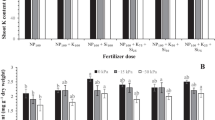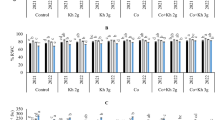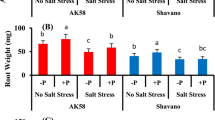Abstract
High temperature (HT) severely limits rice production, but effective measures can reduce the adverse effects of HT. A 2-year experiment was conducted involving five sowing dates to investigate the effects of potassium dihydrogen phosphate (KH2PO4), salicylic acid (SA), and the sowing date on the physiological characteristics, yield and quality of rice subjected to HT. Under ambient HT conditions (daily average temperature ≥ 30 °C for ≥ 3 days or maximum temperature ≥ 35 °C for ≥ 3 days), KH2PO4 (KP1-KP2: 22.05 and 36.75 mmol L−1), SA (SA1-SA2: 0.5 and 1.5 mmol L−1), and their combinations were applied to leaves from the late-booting stage to the flowering stage, with deionized water as a control (CK). Compared with CK, KP1, KP2, SA1, KP1 + SA1, and KP2 + SA1 alleviated the adverse effects of HT on the number of grains per panicle, seed set, and yield, among which SA1, KP2 + SA1, and KP1 were the best. The antioxidant enzyme (superoxide dismutase, peroxidase, and catalase) activities, levels of osmotic protective substances (soluble sugars, soluble proteins, and proline), and chlorophyll content were increased and the malonaldehyde content and leaf temperature were decreased in the SA1, KP2 + SA1, and KP1 treatments. Compared with those sown on April 25 and May 5, plants sown on May 15, May 25, and June 5 had suitable temperature conditions and presented increased grain yield and quality. Therefore, the application of SA1, KP2 + SA1, and KP1 and the use of an optimal sowing date (from May 15 to June 5) increased the rice yield and quality under HT.



Similar content being viewed by others
Data Availability
The authors have no financial or proprietary interests in any of the materials discussed in this article.
References
Arshad MS, Farooq M, Asch F, Krishna JSV, Prasad PVV, Siddique KHM (2017) Thermal stress impacts reproductive development and grain yield in rice. Plant Physiol Biochem 115:57–72. https://doi.org/10.1016/j.plaphy.2017.03.011
Atalay KD, Can GF, Eraslan E (2018) Evaluation of effect of different membership functions on risk assessment. Int J Occup Saf Ergon 24:373–385. https://doi.org/10.1080/10803548.2017.1310519
Benlloch-Gonzalez M, Quintero JM, Suarez MP, Sanchez-Lucas R, Fernandez-Escobar R, Benlloch M (2016) Effect of moderate high temperature on the vegetative growth and potassium allocation in olive plants. J Plant Physiol 207:22–29. https://doi.org/10.1016/j.jplph.2016.10.001
Benlloch-Gonzalez M, Sanchez-Lucas R, Benlloch M (2017) Effects of olive root warming on potassium transport and plant growth. J Plant Physiol 218:182–188. https://doi.org/10.1016/j.jplph.2017.07.018
Cao N, Chen XR, He HH, Zhu CL, Cai S, Xu T, Xie HW, Liu FP (2017) Effects of spraying P and K fertilizers during panicle primordium differentiation stage on cold resistance, yield and physiological characteristics of early rice. Ying Yong Sheng Tai Xue Bao 28:3562–3570. https://doi.org/10.13287/j.1001-9332.201711.030
Chun A, Lee HJ, Hamaker BR, Janaswamy S (2015) Effects of ripening temperature on starch structure and gelatinization, pasting, and cooking properties in rice (Oryza sativa). J Agric Food Chem 63:3085–3093. https://doi.org/10.1021/jf504870p
Cingoz GS, Gurel E (2016) Effects of salicylic acid on thermotolerance and cardenolide accumulation under high temperature stress in Digitalis trojana Ivanina. Plant Physiol Biochem 105:145–149. https://doi.org/10.1016/j.plaphy.2016.04.023
Clarke SM, Cristescu SM, Miersch O, Harren FJ, Wasternack C, Mur LA (2009) Jasmonates act with salicylic acid to confer basal thermotolerance in Arabidopsis thaliana. New Phytol 182:175–187. https://doi.org/10.1111/j.1469-8137.2008.02735.x
Ding Y, Zhao J, Nie Y, Fan B, Wu S, Zhang Y, Sheng J, Shen L, Zhao R, Tang X (2016) Salicylic-acid-induced chilling- and oxidative-stress tolerance in relation to gibberellin homeostasis, C-repeat/dehydration-responsive element binding factor pathway, and antioxidant enzyme systems in cold-stored tomato fruit. J Agric Food Chem 64:8200–8206. https://doi.org/10.1021/acs.jafc.6b02902
Fahad S, Hussain S, Saud S et al (2016a) Responses of rapid viscoanalyzer profile and other rice grain qualities to exogenously applied plant growth regulators under high day and high night temperatures. PLoS ONE 11:e0159590. https://doi.org/10.1371/journal.pone.0159590
Fahad S, Hussain S, Saud S, Hassan S, Ihsan Z, Shah AN, Wu C, Yousaf M, Nasim W, Alharby H, Alghabari F, Huang J (2016b) Exogenously applied plant growth regulators enhance the morpho-physiological growth and yield of rice under high temperature. Front Plant Sci 7:1250. https://doi.org/10.3389/fpls.2016.01250
Feng B, Zhang C, Chen T, Zhang X, Tao L, Fu G (2018) Salicylic acid reverses pollen abortion of rice caused by heat stress. BMC Plant Biol 18:245. https://doi.org/10.1186/s12870-018-1472-5
Ferrari S, Pagliari P, Trettel J (2018) Optimum sowing date and genotype testing for upland rice production in Brazil. Sci Rep 8:8227. https://doi.org/10.1038/s41598-018-26628-6
Fu G, Feng B, Zhang C, Yang Y, Yang X, Chen T, Zhao X, Zhang X, Jin Q, Tao L (2016) Heat stress is more damaging to superior spikelets than inferiors of rice (Oryza sativa L.) due to their different organ temperatures. Front Plant Sci 7:1637. https://doi.org/10.3389/fpls.2016.01637
Gautam P, Lal B, Nayak AK, Raja R, Panda BB, Tripathi R, Shahid M, Kumar U, Baig MJ, Chatterjee D, Swain CK (2019) Inter-relationship between intercepted radiation and rice yield influenced by transplanting time, method, and variety. Int J Biometeorol 63:337–349. https://doi.org/10.1007/s00484-018-01667-w
Gonzalez-Schain N, Dreni L, Lawas LM, Galbiati M, Colombo L, Heuer S, Jagadish KS, Kater MM (2016) Genome-wide transcriptome analysis during anthesis reveals new insights into the molecular basis of heat stress responses in tolerant and sensitive rice varieties. Plant Cell Physiol 57:57–68. https://doi.org/10.1093/pcp/pcv174
Greer DH (2019) Modelling the seasonal changes in the gas exchange response to CO2 in relation to short-term leaf temperature changes in Vitis vinifera cv. Shiraz grapevines grown in outdoor conditions. Plant Physiol Biochem 142:372–383. https://doi.org/10.1016/j.plaphy.2019.07.018
Hirabayashi H, Sasaki K, Kambe T et al (2015) qEMF3, a novel QTL for the early-morning flowering trait from wild rice, Oryza officinalis, to mitigate heat stress damage at flowering in rice O Sativa. J Exp Bot 66:1227–1236. https://doi.org/10.1093/jxb/eru474
Huang J, Zhang F, Xue Y, Lin J (2017) Recent changes of rice heat stress in Jiangxi province, southeast China. Int J Biometeorol 61:623–633. https://doi.org/10.1007/s00484-016-1239-3
IPCC (2018) Special report on global warming of 1.5 °C (SR15). Cambridge University Press, Cambridge
Ishimaru T, Hirabayashi H, Ida M, Takai T, San-Oh YA, Yoshinaga S, Ando I, Ogawa T, Kondo M (2010) A genetic resource for early-morning flowering trait of wild rice Oryza officinalis to mitigate high temperature-induced spikelet sterility at anthesis. Ann Bot 106:515–520. https://doi.org/10.1093/aob/mcq124
Jagadish SV, Muthurajan R, Oane R, Wheeler TR, Heuer S, Bennett J, Craufurd PQ (2010) Physiological and proteomic approaches to address heat tolerance during anthesis in rice (Oryza sativa L.). J Exp Bot 61:143–156. https://doi.org/10.1093/jxb/erp289
Jagadish SV, Murty MV, Quick WP (2015) Rice responses to rising temperatures—challenges, perspectives and future directions. Plant Cell Environ 38:1686–1698. https://doi.org/10.1111/pce.12430
Kaya C, Ashraf M, Alyemeni MN, Ahmad P (2020) The role of endogenous nitric oxide in salicylic acid-induced up-regulation of ascorbate-glutathione cycle involved in salinity tolerance of pepper (Capsicum annuum L.) plants. Plant Physiol Biochem 147:10–20. https://doi.org/10.1016/j.plaphy.2019.11.040
Khan MI, Iqbal N, Masood A, Per TS, Khan NA (2013) Salicylic acid alleviates adverse effects of heat stress on photosynthesis through changes in proline production and ethylene formation. Plant Signal Behav 8:e26374. https://doi.org/10.4161/psb.26374
Khan S, Anwar S, Ashraf MY, Khaliq B, Sun M, Hussain S, Gao ZQ, Noor H, Alam S (2019) Mechanisms and adaptation strategies to improve heat tolerance in rice. Rev Plants (basel) 8:508. https://doi.org/10.3390/plants8110508
Kim EH, Kim YS, Park SH, Koo YJ, Choi YD, Chung YY, Lee IJ, Kim JK (2009) Methyl jasmonate reduces grain yield by mediating stress signals to alter spikelet development in rice. Plant Physiol 149:1751–1760. https://doi.org/10.1104/pp.108.134684
Kim Y, Mun BG, Khan AL, Waqas M, Kim HH, Shahzad R, Imran M, Yun BW, Lee IJ (2018) Regulation of reactive oxygen and nitrogen species by salicylic acid in rice plants under salinity stress conditions. PLoS ONE 13:e0192650. https://doi.org/10.1371/journal.pone.0192650
Larkindale J, Knight MR (2002) Protection against heat stress-induced oxidative damage in Arabidopsis involves calcium, abscisic acid, ethylene, and salicylic acid. Plant Physiol 128:682–695. https://doi.org/10.1104/pp.010320
Li ZG, Xie LR, Li XJ (2015) Hydrogen sulfide acts as a downstream signal molecule in salicylic acid-induced heat tolerance in maize (Zea mays L.) seedlings. J Plant Physiol 177:121–127. https://doi.org/10.1016/j.jplph.2014.12.018
Lin G, Yang Y, Chen X, Yu X, Wu Y, Xiong F (2020) Effects of high temperature during two growth stages on caryopsis development and physicochemical properties of starch in rice. Int J Biol Macromol 145:301–310. https://doi.org/10.1016/j.ijbiomac.2019.12.190
Mohammed AR, Tarpley L (2009) High nighttime temperatures affect rice productivity through altered pollen germination and spikelet fertility. Agric for Meteorol 149:999–1008. https://doi.org/10.1016/j.agrformet.2008.12.003
Mostofa MG, Fujita M (2013) Salicylic acid alleviates copper toxicity in rice (Oryza sativa L.) seedlings by up-regulating antioxidative and glyoxalase systems. Ecotoxicology 22:959–973. https://doi.org/10.1007/s10646-013-1073-x
Munne-Bosch S, Penuelas J (2003) Photo- and antioxidative protection, and a role for salicylic acid during drought and recovery in field-grown Phillyrea angustifolia plants. Planta 217:758–766. https://doi.org/10.1007/s00425-003-1037-0
Prasad PVV, Djanaguiraman M (2011) High night temperature decreases leaf photosynthesis and pollen function in grain Sorghum. Funct Plant Biol 38:993–1003. https://doi.org/10.1071/fp11035
Prasad PVV, Boote KJ, Allen JLH, Sheehy JE, Thomas JMG (2006) Species, ecotype and cultivar differences in spikelet fertility and harvest index of rice in response to high temperature stress. Field Crops Res 95:398–411. https://doi.org/10.1007/s00484-016-1239-3
Rao MV, Paliyath G, Ormrod DP, Murr DP, Watkins CB (1997) Influence of salicylic acid on H2O2 production, oxidative stress, and H2O2-metabolizing enzymes. Salicylic acid-mediated oxidative damage requires H2O2. Plant Physiol 115:137–149. https://doi.org/10.1104/pp.115.1.137
Rezaul IM, Baohua F, Tingting C, Weimeng F, Caixia Z, Longxing T, Guanfu F (2019) Abscisic acid prevents pollen abortion under high-temperature stress by mediating sugar metabolism in rice spikelets. Physiol Plant 165:644–663. https://doi.org/10.1111/ppl.12759
Shabala S, Cuin TA (2008) Potassium transport and plant salt tolerance. Physiol Plant 133:651–669. https://doi.org/10.1111/j.1399-3054.2007.01008.x
Shahid M, Nayak AK, Tripathi R, Katara JL, Bihari P, Lal B, Gautam P (2018) Boron application improves yield of rice cultivars under high temperature stress during vegetative and reproductive stages. Int J Biometeorol 62:1375–1387. https://doi.org/10.1007/s00484-018-1537-z
Sharma A, Sidhu GPS, Araniti F, Bali AS, Shahzad B, Tripathi DK, Brestic M, Skalicky M, Landi M (2020) The role of salicylic acid in plants exposed to heavy metals. Molecules 25:540. https://doi.org/10.3390/molecules25030540
Sheteiwy MS, An J, Yin M, Jia X, Guan Y, He F, Hu J (2019) Cold plasma treatment and exogenous salicylic acid priming enhances salinity tolerance of Oryza sativa seedlings. Protoplasma 256:79–99. https://doi.org/10.1007/s00709-018-1279-0
Shi P, Tang L, Wang L, Sun T, Liu L, Cao W, Zhu Y (2015) Post-heading heat stress in rice of South China during 1981–2010. PLoS ONE 10:e0130642. https://doi.org/10.1371/journal.pone.0130642
Shi W, Li X, Schmidt RC, Struik PC, Yin X, Jagadish SVK (2018) Pollen germination and in vivo fertilization in response to high-temperature during flowering in hybrid and inbred rice. Plant Cell Environ 41:1287–1297. https://doi.org/10.1111/pce.13146
Sohag AAM, Tahjib-Ul-Arif M, Brestic M, Afrin S, Sakil MA, Hossain MT, Hossain MT, Hossain MA (2020) Exogenous salicylic acid and hydrogen peroxide attenuate drought stress in rice. Plant Soil Environ 66:7–13. https://doi.org/10.17221/472/2019-pse
Song Y, Xuan A, Bu C, Liu X, Zhang D (2020) Identification of a transcriptional regulatory module that reduces leaf temperature in poplar under heat stress. Tree Physiol 40:1108–1125. https://doi.org/10.1093/treephys/tpaa025
Tang S, Zhang H, Li L, Liu X, Chen L, Chen W, Ding Y (2018) Exogenous spermidine enhances the photosynthetic and antioxidant capacity of rice under heat stress during early grain-filling period. Funct Plant Biol 45:911–921. https://doi.org/10.1071/FP17149
Tang S, Zhang H, Liu W, Dou Z, Zhou Q, Chen W, Wang S, Ding Y (2019) Nitrogen fertilizer at heading stage effectively compensates for the deterioration of rice quality by affecting the starch-related properties under elevated temperatures. Food Chem 277:455–462. https://doi.org/10.1016/j.foodchem.2018.10.137
Torrens-Spence MP, Bobokalonova A, Carballo V, Glinkerman CM, Pluskal T, Shen A, Weng JK (2019) PBS3 and EPS1 complete salicylic acid biosynthesis from isochorismate in Arabidopsis. Mol Plant 12:1577–1586. https://doi.org/10.1016/j.molp.2019.11.005
Wang LJ, Fan L, Loescher W, Duan W, Liu GJ, Cheng JS, Luo HB, Li SH (2010) Salicylic acid alleviates decreases in photosynthesis under heat stress and accelerates recovery in grapevine leaves. BMC Plant Biol 10:34. https://doi.org/10.1186/1471-2229-10-34
Wang QJ, Sun H, Dong QL, Sun TY, Jin ZX, Hao YJ, Yao YX (2016) The enhancement of tolerance to salt and cold stresses by modifying the redox state and salicylic acid content via the cytosolic malate dehydrogenase gene in transgenic apple plants. Plant Biotechnol J 14:1986–1997. https://doi.org/10.1111/pbi.12556
Welch J, Vincent J, Auffhammer M, Moya P, Dobermann A, Dawe D (2010) Rice yields in tropical/subtropical Asia exhibit large but opposing sensitivities to minimum and maximum temperatures. Proc Natl Acad Sci USA 107:14562–14567. https://doi.org/10.1073/pnas.1001222107
Wu P, Shou H, Xu G, Lian X (2013) Improvement of phosphorus efficiency in rice on the basis of understanding phosphate signaling and homeostasis. Curr Opin Plant Biol 16:205–212. https://doi.org/10.1016/j.pbi.2013.03.002
Wu C, Tang S, Li G, Wang S, Fahad S, Ding Y (2019) Roles of phytohormone changes in the grain yield of rice plants exposed to heat: a review. PeerJ 7:e7792. https://doi.org/10.7717/peerj.7792
Yang J, Chen X, Zhu C, Peng X, He X, Fu J, Ouyang L, Bian J, Hu L, Sun X, Xu J, He H (2015) Using RNA-seq to profile gene expression of spikelet development in response to temperature and nitrogen during meiosis in rice (Oryza sativa L.). PLoS ONE 10:e0145532. https://doi.org/10.1371/journal.pone.0145532
Yang Z, Zhang Z, Zhang T, Fahad S, Cui K, Nie L, Peng S, Huang J (2017) The effect of season-long temperature increases on rice cultivars grown in the central and southern regions of China. Front Plant Sci 8:1908. https://doi.org/10.3389/fpls.2017.01908
Yang J, Cai Z, Liu D, Hu LY, Qu WB, Zhang CH, Wang SM, Tian J (2019) Effects of spraying salicylic acid and potassium dihydrogen phosphate on physiological cha-racteristics and grain yield of single-season rice under high temperature condition. Ying Yong Sheng Tai Xue Bao 30:4202–4210. https://doi.org/10.13287/j.1001-9332.201912.029
Yao D, Wu J, Luo Q, Li J, Zhuang W, Xiao G, Deng Q, Lei D, Bai B (2020) Influence of high natural field temperature during grain filling stage on the morphological structure and physicochemical properties of rice (Oryza sativa L.) starch. Food Chem 310:125817. https://doi.org/10.1016/j.foodchem.2019.125817
Zhang C, Zhou L, Zhu Z, Lu H, Zhou X, Qian Y, Li Q, Lu Y, Gu M, Liu Q (2016) Characterization of grain quality and starch fine structure of two Japonica rice (Oryza sativa) cultivars with good sensory properties at different temperatures during the filling stage. J Agric Food Chem 64:4048–4057. https://doi.org/10.1021/acs.jafc.6b00083
Zhang R, Zhou Y, Yue Z, Chen X, Cao X, Ai X, Jiang B, Xing Y (2019) The leaf-air temperature difference reflects the variation in water status and photosynthesis of Sorghum under waterlogged conditions. PLoS ONE 14:e0219209. https://doi.org/10.1371/journal.pone.0219209
Zhao C, Liu B, Piao S et al (2017) Temperature increase reduces global yields of major crops in four independent estimates. Proc Natl Acad Sci USA 114:9326–9331. https://doi.org/10.1073/pnas.1701762114
Zhao Q, Zhou L, Liu J, Du X, Asad MA, Huang F, Pan G, Cheng F (2018a) Relationship of ROS accumulation and superoxide dismutase isozymes in developing anther with floret fertility of rice under heat stress. Plant Physiol Biochem 122:90–101. https://doi.org/10.1016/j.plaphy.2017.11.009
Zhao Q, Zhou L, Liu J, Cao Z, Du X, Huang F, Pan G, Cheng F (2018b) Involvement of CAT in the detoxification of HT-induced ROS burst in rice anther and its relation to pollen fertility. Plant Cell Rep 37:741–757. https://doi.org/10.1007/s00299-018-2264-y
Funding
This work was supported by the National Natural Science Foundation of China (No. 41965008) and the Key Research and Development Program of Jiangxi Province (No. 20192BBFL60040 and 20165ABC28008).
Author information
Authors and Affiliations
Contributions
JY conceived and designed the research. JY and LD performed the experiments. JY and LD analyzed the data and wrote the manuscript. SH greatly contributed to guiding the process of the experiments. HH and YL revised and edited the manuscript and provided advice for the experiments. XL, DL, JW, and GJ helped with sampling, experimentation, and manuscript writing.
Corresponding author
Ethics declarations
Conflict of interest
The authors have no conflict of interest to declare that are relevant to the content of this article.
Additional information
Handling Editor: Rhonda Peavy.
Publisher's Note
Springer Nature remains neutral with regard to jurisdictional claims in published maps and institutional affiliations.
Rights and permissions
About this article
Cite this article
Yang, J., Duan, L., He, H. et al. Application of Exogenous KH2PO4 and Salicylic Acid and Optimization of the Sowing Date Enhance Rice Yield Under High-Temperature Conditions. J Plant Growth Regul 41, 1532–1546 (2022). https://doi.org/10.1007/s00344-021-10399-y
Received:
Accepted:
Published:
Issue Date:
DOI: https://doi.org/10.1007/s00344-021-10399-y




